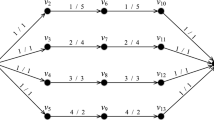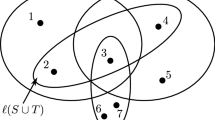Abstract
In optimization, it is common to deal with uncertain and inaccurate factors which make it difficult to assign a single value to each parameter in the model. It may be more suitable to assign a set of values to each uncertain parameter. A scenario is defined as a realization of the uncertain parameters. In this context, a robust solution has to be as good as possible on a majority of scenarios and never be too bad. Such characterization admits numerous possible interpretations and therefore gives rise to various approaches of robustness. These approaches differ from each other depending on models used to represent uncertain factors, on methodology used to measure robustness, and finally on analysis and design of solution methods. In this paper, we focus on the application of a recent criterion for the shortest path problem with uncertain arc lengths. We first present two usual uncertainty models: the interval model and the discrete scenario set model. For each model, we then apply a criterion, called bw-robustness (originally proposed by B. Roy) which defines a new measure of robustness. According to each uncertainty model, we propose a formulation in terms of large scale integer linear program. Furthermore, we analyze the theoretical complexity of the resulting problems. Our computational experiments perform on a set of large scale graphs. By observing the results, we can conclude that the approved solvers, e.g. Cplex, are able to solve the mathematical models proposed which are promising for robustness analysis. In the end, we show that our formulations can be applied to the general linear program in which the objective function includes uncertain coefficients.
Similar content being viewed by others
References
Aissi, H., Bazgan, C., & Vanderpooten, D. (2005). Complexity of the min-max and min-max regret assignment problems. Operations Research Letters, 33(6), 634–640.
Atamtürk, A., & Zhang, M. (2007). Two-stage robust network flow and design under demand uncertainty. Operations Research, 55(4), 662–673.
Averbakh, I. (2001). On the complexity of a class of combinatorial optimization problems with uncertainty. Mathematical Programming Series A, 90(6), 263–272.
Averbakh, I., & Lebedev, V. (2004). Interval data minmax regret network optimization problems. Discrete Applied Mathematics, 138, 289–301.
Bertsimas, D., & Sim, M. (2003). Robust discrete optimization and network flows. Mathematical Programming Series B, 98, 49–71.
Bertsimas, D., & Sim, M. (2004). The price of robustness. Operations Research, 52(1), 35–53.
Deĭneko, V. G., & Woeginger, G. J. (2006). On the robust assignment problem under a fixed number of cost scenarios. Operations Research Letters, 34(2), 175–179.
Gabrel, V., & Murat, C. (2010a). Paradigms of combinatorial optimization: problems and new approaches. In Robust shortest path problems (pp. 615–639), New York: Wiley-ISTE.
Gabrel, V., & Murat, C. (2010b). Robustness and duality in linear programming. The Journal of the Operational Research Society, 61, 1288–1296.
Gabrel, V., Murat, C., & Remli, N. (2010a). Linear programming with interval right handsides. International Transactions in Operational Research, 3(17), 397–408.
Gabrel, V., Murat, C., Remli, N., & Lacroix, M. (2010b). Recourse problem of the 2-stage robust location transportation problem. Electronic Notes in Discrete Mathematics, 36, 167–174.
Gabrel, V., Murat, C., & Wu, L. (2010c). Application d’un nouveau critère de robustesse pour le problème du plus court chemin (Technical report 48). LAMSADE.
Kalai, R., Aloulou, M., Vallin, P., & Vanderpooten, D. (2005). Robust 1-median location problem on a tree. In Proceedings of the ORP3 meeting, Valencia, Spain.
Karaşan, O. E., Pınar, M. Ç., & Yaman, H. (2001). The robust shortest path problem with interval data (Technical report). Bilkent University.
Kasperski, A., & Zieliński, P. (2006). The robust shortest path problem in series-parallel multidigraphs with interval data. Operations Research Letters, 34(1), 69–76.
Kouvelis, P., & Yu, G. (1997). Robust discrete optimization and its applications. Boston: Kluwer Academic.
Montemanni, R. (2006). A benders decomposition approach for the robust spanning tree problem with interval data. European Journal of Operational Research, 174(3), 1479–1490.
Montemanni, R., & Gambardella, L. (2004). An exact algorithm for the robust shortest path problem with interval data. Computers & Operations Research, 31, 1667–1680.
Montemanni, R., & Gambardella, L. (2005). The robust path problem with interval data via benders decomposition. 4OR, 3(4), 315–328.
Montemanni, R., Gambardella, L., & Donati, A. (2004). A branch and bound algorithm for the robust shortest path problem with interval data. Operations Research Letters, 32, 225–232.
Perny, P., & Spanjaard, O. (2003). An axiomatic approach to robustness in search problems with multiple scenarios. In Proceedings of the 19th conference on uncertainty in artificial intelligence (pp. 469–476), Acapulco, Mexico.
Roy, B. (2005). A propos de robustesse en recherche Opérationnelle et Aide à la Décision. In Flexibilité et robustesse en ordonnancement. Paris: Hermès.
Roy, B. (2007). La robustesse en recherche opérationnelle et aide à la décision: une préoccupation multi-facettes. In Robustness in OR-DA, annales du LAMSADE (pp. 209–236). Paris: Université Paris Dauphine.
Roy, B. (2010). Robustness in operational research and decision aiding: a multi-faceted issue. European Journal of Operational Research, 200(3), 629–638.
Spanjaard, O. (2003). Exploitation de préférences non-classiques dans les problèmes combinatoires: modèles et algorithmes pour les graphes. Thèse de doctorat, Université Paris Dauphine—LAMSADE.
Vincke, P. (1999). Robust solutions and methods in decision-aid. Journal of Multi-Criteria Decision Analysis, 8, 181–187.
Yaman, H., Karaşan, O. E., & Pınar, M. Ç. (2001). The robust spanning tree problem with interval data. Operations Research Letters, 29, 31–40.
Yu, G., & Yang, J. (1998). On the robust shortest path problem. Computers & Operations Research, 25(6), 457–468.
Zieliński, P. (2004). The computational complexity of the relative robust shortest path problem with interval data. European Journal of Operational Research, 158, 570–576.
Author information
Authors and Affiliations
Corresponding author
Rights and permissions
About this article
Cite this article
Gabrel, V., Murat, C. & Wu, L. New models for the robust shortest path problem: complexity, resolution and generalization. Ann Oper Res 207, 97–120 (2013). https://doi.org/10.1007/s10479-011-1004-2
Published:
Issue Date:
DOI: https://doi.org/10.1007/s10479-011-1004-2




